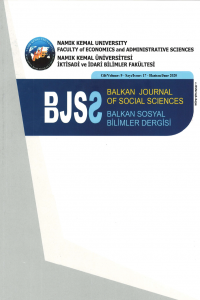Abstract
Bu çalışmada, işsizlik oranı ile açık iş oranı arasındaki negatif ilişkiyi gösteren Beveridge eğrisinin Türkiye’de 2006:01-2020:03 döneminde geçerliliği incelenmiştir. Beveridge eğrisinin incelenmesinde ekonometrik yöntemlerden Hatemi-J (2008) çoklu yapısal kırılmalı eşbütünleşme testinden yararlanılmıştır. Uzun dönem katsayıları tespit etmek amacıyla FMOLS yönteminden yararlanılmıştır. Değişkenler arasındaki nedenselliğin yönünü tespit edebilmek için de Hacker ve Hatemi-J (2012) Bootstrap nedensellik testinden yararlanılmıştır. Elde edilen bulgulara göre, Türkiye’de işsizlik oranı ile açık iş oranı değişkenleri arasında uzun dönemli eşbütünleşme ilişkisi tespit edilmiştir. Uzun dönemde açık iş oranında meydana gelecek %1’lik artışın, işsizlik oranını %-0.15 oranında düşüreceği tespit edilmiştir. Hacker ve Hatemi-J (2012) bootstrap nedensellik testi sonuçlarına göre, açık iş(e) oranından işsizliğe doğru nedensellik ilişkisi olduğu tespit edilmiştir.
Keywords
Beveridge Eğrisi Hatemi-J (2008) Eşbütünleşme Testi Hacker ve Hatemi-J (2012) Bootstrap Nedensellik Testi
References
- Acuna, H., Carrasco, D., Carrasco, M. & Caro F. (2018), Dynamics of the Beveridge curve and global crises. Advances in Economics and Business, 6 (4), 218-231.
- Ağayev, S. & Bora, A. (2012). Türkiye için Beveridge eğrisi ve emek piyasası üzerine bir inceleme. Finans Politik & Ekonomik Yorumlar, 49 (565), 23-36.
- Altunöz, U. (2015). Beveridge eğrisi ile Türkiye’nin işgücü piyasası analizi. Kamu –İş, 14 (2), 47-65.
- Aydın, N. (2012). İşsizlik, Beveridge eğrisi ve Türkiye işgücü piyasasına ilişkin bir değerlendirme. Dumlupınar Üniversitesi Sosyal Bilimler Dergisi, 2 (35), 119 - 134.
- Bayraktar Saglam, B. & Gunalp B. (2012). The Beveridge curve and labour market dynamics in Turkey. Applied Economics, 44, 3195–3202.
- Beveridge, W. H. (1944). Full employment in a free society. New York: W. W. Norton & Company.
- Bilen, Ö., Bilen Kazancık, L. & Doğan, İ. (2018). Türkiye işgücü piyasasında arama ve eşleştirme modeli. Sayıştay Dergisi, 108, 73-97.
- Blanchard, O.J. & Diamond, P. (1989). The Beveridge curve. Brookings Papers on Economic Activity, 1, 1-76.
- Bleakley, H. & Führer, J.C. (1997). Shifts in the Beveridge curve, job matching and labor market dynamics. New England Economic Review, September/October, 3–19.
- Bonthuis, B. Jarvis, V. & Vanhala, J. (2013). What’s going on behind the Euro area beveridge curve(s)?. Working Paper Series, 1586: 1-44.
- Bova, E., Jalles, J. T., & Kolerus, C. (2016). Shifting the Beveridge curve: what affects labor market matching?. IMF Working Paper,WP/16/93.
- Börsch-Supan, A.H. (1991). Panel data analysis of the Beveridge curve: ıs there a macroeconomic relation between the rate of unemployment and the vacancy rate?. Economica, New Series,58 (231), 279-297.
- Çağlarırmak Uslu, N., Karahan-Dursun, P. & Çer, Ş. (2019). Türkiye’de Beveridge eğrisinin geçerliliğine ilişkin ampirik bir analiz. Aksaray Üniversitesi İktisadi ve İdari Bilimler Fakültesi Dergisi, 11(1), 43-52.
- Dickey, D., & Fuller, W. (1981), Likelihood Ratio Statistics for Autoregressive Time Series with a Unit Root, Econometrica, 49(4), 1057-1072.
- Dow, J. & Dicks-Mireaux, L. (1958). The excess demand for labour: a study of conditions in Great Britain, 1946– 56. Oxford Economic Papers, 10, 1–33.
- Hacker, R. Scott. & Abdulnasser Hatemi-J (2012). A bootstrap test for causality with endogenous lag length choice: theory and application in finance. Journal of Economic Studies, 39 (2), 144-160.
- Hatemi-J, A. (2008), Tests for cointegration with two unknown regime shifts with an application to financial market integration, Empirical Economics, 35(3), 497–505. Kanık, B., Sunel E. & Taşkın T. (2012). Beveridge eğrisi ve eşleşme fonksiyonu: Türkiye örneği. TCMB Ekonomi Notları, 2012-24.
- Kasrin, Z. & Lang G. (2010). Estimating the Beveridge curve of Egypt: An econometric study for the period 2004 to 2010. German University in Cairo. Working Paper, 21:1-24. Keskin, A. & Şen, H. (2010). Beveridge eğrisi: teori ve Türkiye uygulaması. TİSK Akademi, 2010 (II), 199-219.
- Lee, J & Strazicich, M. C. (2013), Minimum LM unit root test with one structural break, Economics Bulletin, 33(4), 2483-2492.
- Pater, R. (2017). Is there a Beveridge curve in the short and the long run?. Journal of Applied Economics, XX (2), 283-303.
- Tagkalakis, A. O. (2016). Unemployment dynamics and the Beveridge curve in Greece. Journal of European Labor Studies, 5(13), 1-34.
- Tanrıöver, B. & Biçer B. (2015). Yapısal şokların emek piyasası üzerindeki etkileri: Türkiye için Beveridge eğrisi tahmini. International Journal of Academic Value Studies, 1(1), 12-25.
- Tokatlıoğlu, İ. (2016). Küresel kriz öncesi ve sonrası dönem için Türkiye’nin Beveridge eğrisi tahmini. Hacettepe Üniversitesi İktisadi ve İdari Bilimler Fakültesi Dergisi, 34(3), 73-105.
- Yashiv, E. (2008), The Beveridge Curve in L. Blume, S.N. Durlauf (eds). The New Palgrave Dictionary of Economics, (2nd) edition. http://www.tau.ac.il/~yashiv/beveridge.pdf
Details
| Primary Language | Turkish |
|---|---|
| Subjects | Economics |
| Journal Section | Research Article |
| Authors | |
| Publication Date | June 30, 2020 |
| Acceptance Date | May 31, 2020 |
| Published in Issue | Year 2020 Volume: 9 Issue: 17 |

